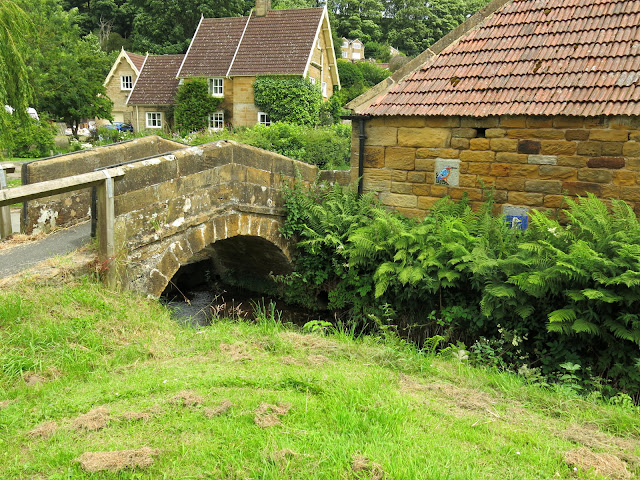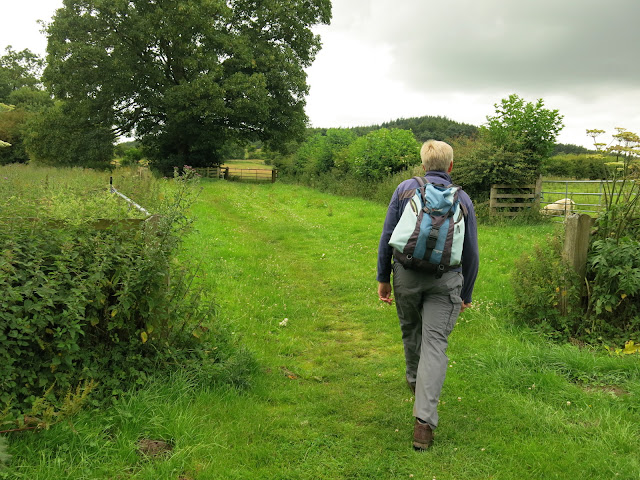Kirby Knowle to Felixkirk and Boltby
8.5 miles Fine and cool
We approached Kirby Knowle from the Knayton A19 turn-off and parked at the side of the road opposite St Wilfred's Chuch.
 |
| Today's walk from The Walker's Guide to the Hambleton Hills |
 |
| St Wilfred's Church |
 |
| Well maintained interior of St Wilfred's, the organ can be seen on the left |
Unlike our last visit to Kirby Knowle, St Wilfred's Church was unlocked, so we went in for a look around. The church is very clean and tidy, it was rebuilt on the site of an older building in 1873 and has nice leaded glass windows. We were particularly taken with a modern window that is a memorial to a lady doctor and featured Alexander Fleming and Elizabeth Garrett Anderson, the first woman to qualify as a doctor and surgeon in Britain.
 |
| We liked this modern stained glass window |
 |
| The window is a memorial to a doctor |
We left the church and walked out of the village towards Upsall and looked up towards the distant but imposing dwelling of Newbuilding. Although it is called Newbuilding TSB explains that it actually dates from the 13th century. It has been restored and modernised but still contains many of its original features.
 |
| 'Newbuilding' |
Just before Upsall we turned off the road into fields and followed an unwalked and very overgrown path to Turton Beckstead. Beckstead means 'a farm near a river' and as we reached the beck we saw a stone
clearly engraved 'The Turton Beckstead' embedded in the dry stone wall
adjacent to the beck. It looks as if an old bridge has collapsed here. TSB informs us that in the 1860s some mourners
were carrying a body to Kirby Knowle for burial. The bearers set down
the coffin to briefly rest at this spot but on lifting it again it felt
much lighter and they discovered that the corpse had disappeared. The
empty coffin was buried and the site at Beckstead Wood became known as
Lost Corpse End.
 |
| Leaving the road before Upsall |
 |
| Walking across fields |
 |
| Most of the gates on this walk had been unnecessarily tied shut with baling twine |
 |
| Our track is unwalked |
 |
| Leaving the fields to approach Turton Beckstead |
 |
| Old carved stone near beck |
 |
| Looks like an old bridge has collapsed here. The stone above is just to the right of Clive |
|
|
We soon arrived at the road and walked into Felixkirk. Once again we were fortunate to find the church unlocked, unlike previous visits, and we were able to go inside. St Felix's is a large church for the size of the village and in very good repair. Nice windows and again I was impressed by a modern window, dedicated to a retired army officer.
 |
| Looking down towards Thirsk from the path to Felixkirk |
 |
| Awkward stile and slippery bridge |
 |
| St Felix, Felixkirk |
 |
| Airy domed ceiling |
 |
| Altar window |
 |
| Modern stained glass window |
As you can see from the above photograph of the church, the graveyard has been recently fenced off so it is difficult to see the interesting old gravestones such as that of Hannah Cornforth, photographed on a previous visit.
 |
| 'Twenty years I was a maid, 1 year I was a wife. 18 hours a mother, and then departed life' |
 |
| Felixkirk |
We retraced our steps to the outskirts of Felixkirk and turned right at a road junction and passed the lodge to Mount St John,
once a preceptory in the days of Henry I. We turned right down a lane
towards Cinque Cliff House where the path has been diverted by the new
owners through fields around the back of the house. While on this diversion we found that we were sheltered from the breeze and sat on the sloping fields with a nice view to our left of Whitestone Cliff, to enjoy our coffee and scones.
 |
| The lodge to Mount St John |
 |
| We bear right across the cattle grid towards Cinque House |
 |
| Taking the new diversion around Cinque House |
 |
| A pleasant place to sit for a while |
 |
| Cinque House |
We set off once more and our diversion rejoined the track below Cinque House and we followed a grassy lane to the road where we turned left and walked into Thirlby.
 |
| Green Lane |
 |
| Some nice weathervanes in Thirlby |
Thirlby is famous as the home of a woodcarver, Bob Hunter, who worked with 'Mouseman' Thomson of nearby Kilburn. Bob used the trademark of a wren and his workshop is Pear Tree House down by the ford.
 |
| The workshop of the Wren Man |
 |
| Detail from the front porch |
 |
| The workshop next to the ford |
We walked past the workshop and some attractive cottages before turning left into fields.
 |
| Bridge Cottage, Thirlby |
 |
| Walking through Thirlby |
 |
| 'No shop or inn is there here about, so why not sit down and enjoy summat for nowt' - donated by 'two good sorts' |
 |
| Unusual stile near Thirlby |
Just past the ford we left the village
through a gateway into a field where we followed a barely discernible
track to Tang Hall, crossing a couple of becks and an unusual stile on
the way. One stile was extremely muddy and could not be circumnavigated. Fortunately Clive found a branch which could be manoeuvered to form a rudimentary bridge over the mud.
 |
| Leaving the fields to enter a wood |
 |
| A woodland path |
 |
| Clive builds a way through the mud |
 |
| Carefully does it |
We walked through several fields containing cows, horses and sheep to reach Boltby, emerging onto the road next to the packhorse bridge.
 |
| We are watched as we pass by |
 |
| A fine ram |
 |
| Boltby |
 |
| Packhorse bridge at Boltby |
|
|
We turned left at the packhorse bridge and walked through the pretty village of Boltby before turning right at a waymarked sign at the lane between Spring Garth and Gurtof House. We then followed a series of field boundaries to reach the modern mansion of Ravensthorpe Manor.
 |
| Racing weathervane in Boltby |
 |
| Walking through Boltby |
 |
| Leaving the village |
As we approached the manor house we walked through a couple of fields containing horses, which seemed largely indifferent to us. The final field also contained two pigs, one of which ran over to see if Clive had any biscuits. It was in luck. We were also fascinated to see a large brown horse, frozen like a statue, unblinking and unmoving as we walked right up to it. It must have been fast asleep!
 |
| Something has seen us! |
 |
| The horse on the right is fast asleep |
 |
| Not a statue |
 |
| Yummy, biscuits! |
 |
| 'Any for me?' |
 |
| The last of the biscuits |
 |
| Sad to see us go |
As we walked uphill behind Ravensthorpe Manor a large buzzard circled overhead, and when we stood still it came close enough for me to get a photograph.
 |
| A buzzard overhead |
We followed our track through Westow Plantation and then across Birk Bank to return to Kirby Knowle and our car.
 |
| Westow Plantation |
 |
| Birk Bank |
 |
| Kirby Knowle appears in the distance |
 |
| Back to St Wilfred's in Kirby Knowle |


